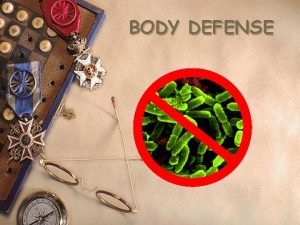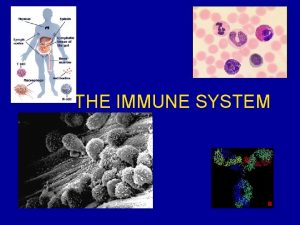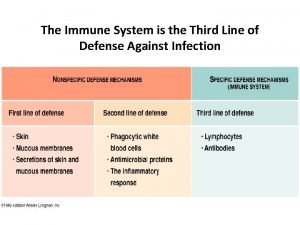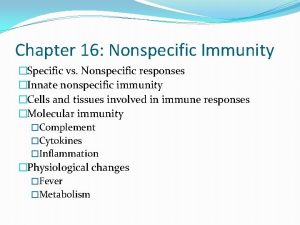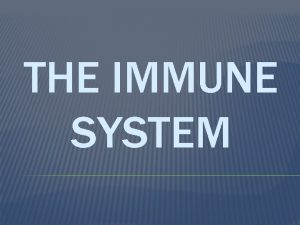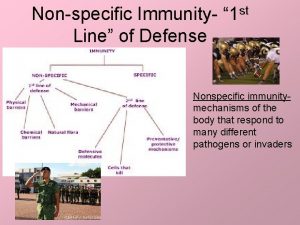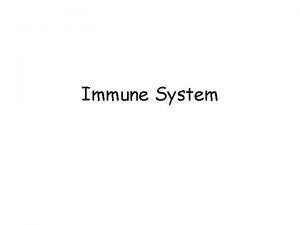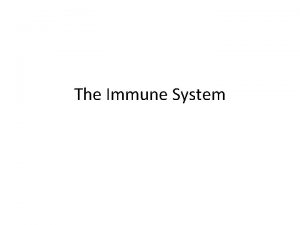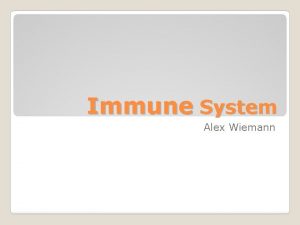Immune System Ji Min Lee NonSpecific Defense 1











- Slides: 11

Immune System Ji Min Lee

Non-Specific Defense 1 st line of defense: skin, hair, stomach acid, mucus, cilia, lysosome (enzyme), and saliva 2 nd line of defense: inflammation, fever, phagocytes Existing from birth Does not target specific pathogens

Specific Defense 3 rd line of defense: B-cells, and T-cells Only vertebrates (have) Targets specific antigens Adaptive Active (permanent/reusable): natural (exposure) or artificial (vaccines) Passive (temporary): natural (antibodies across placenta or in mother’s milk) or artificial (injected)

Inflammation Non-specific defense Increase blood flow to bring white blood cells to site of infection with microbes Results in: redness, pain, swelling, and warmth Also results in fever (short time)-to prevent bacteria from surviving or multiplying (harder to survive and reproduce in extremely high temperatures), and increase rate of tissue repair

Skin Non-specific defense Protect from microbes-prevents infections Regulate body temperature Enables senses Shedding regularly disposes of surface microbes Zooming In Peeling skin is bad for my immune system

Nose Hair Non-specific defense Filter foreign particles (microbes, dust, pollution) from entering nasal cavity Collect moisture

Mucus Non-specific defense Shield lungs from dust, bacteria, exhaust fumes, cigarette smoke, viruses, etc. The Mucus

Phagocytes Non-specific defense Engulf and absorb bacteria, small cells, cancerous cells, and particles Lysosomes with digestive enzymes break down absorbed microbes, cells, and particles Exocytosis-remove indigestible material after absorption of nutrients Like a phagocyte

B-Cells Specific defense Make specific antibodies Memory: dormant until future infection release antibodies Asexual Reproduction Mitosis (Different Reproduction for Me)

Antibodies Specific defense Neutralize: shield antigen and prevent normal function Help phagocytosis: antigen precipitates, and signals phagocytes to attack Agglutination: clump bacteria together, also assists phagocytosis Antigen-antibody complex: lyse foreign cell or cause inflammation for more white blood cells

T-Cells Specific defense Helper: secrete I-2 for more white blood cells Killer: secrete cytotoxin destroy pathogen’s DNA, or perforin to create holes in pathogen’s plasma membrane lyse (rupture) Memory: remain dormant until future infection killer T -cells to fight pathogen We are Clones
 Specific defense vs nonspecific defense
Specific defense vs nonspecific defense Specific vs nonspecific defense
Specific vs nonspecific defense Nonspecific host defense mechanism
Nonspecific host defense mechanism Nonspecific vs specific defense
Nonspecific vs specific defense Primary immune response and secondary immune response
Primary immune response and secondary immune response What is the third line of defense in the immune system
What is the third line of defense in the immune system Third line of defense immune system
Third line of defense immune system Second line of defense immune system
Second line of defense immune system Primary vs secondary immune response
Primary vs secondary immune response The first line of defense
The first line of defense Specific vs nonspecific immunity
Specific vs nonspecific immunity Pulmonary embolus
Pulmonary embolus

